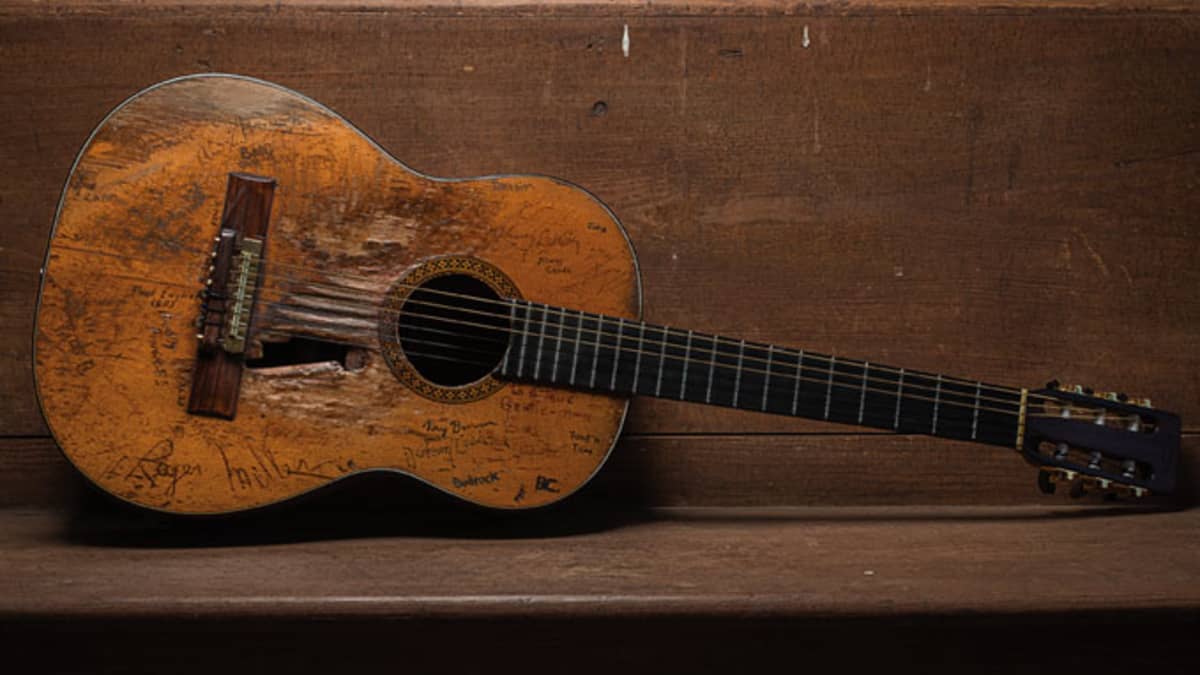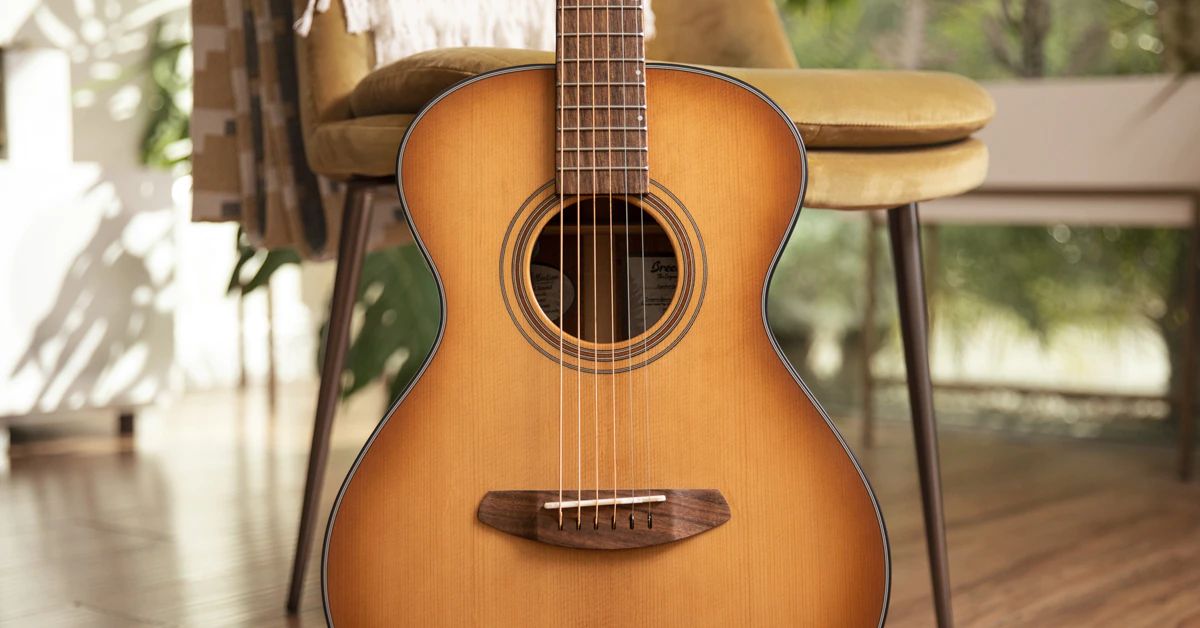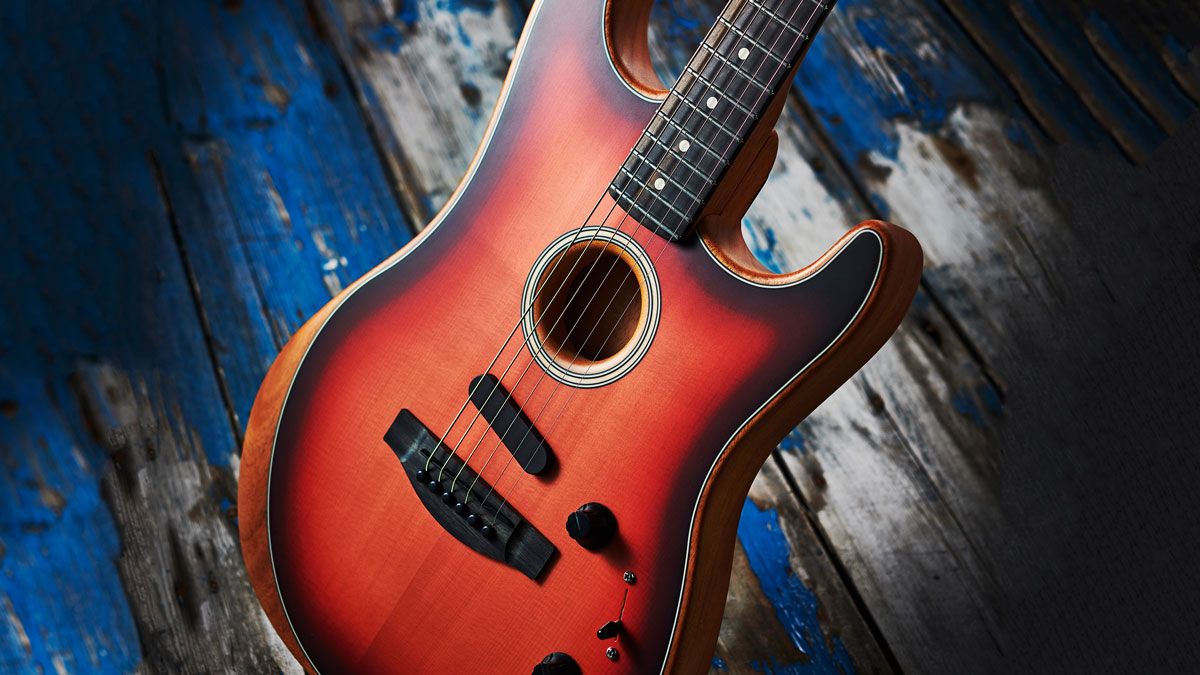Introduction
Guitar picks are an essential accessory for acoustic guitarists. They not only influence the tone and sound produced by the instrument but also play a crucial role in the overall playing experience. With a vast array of options available, it can be overwhelming to choose the right type of pick for your acoustic guitar. In this article, we will explore the different types of guitar picks and discuss the factors to consider when making your selection.
A guitar pick, also known as a plectrum, is a small, flat object that is held between the fingers or thumb to pluck or strum the strings of a guitar. It provides a more precise and controlled attack on the strings compared to using your fingers alone. Additionally, using a pick can produce a brighter and more defined sound, which is especially desired in certain genres of music.
There are several variations of guitar picks available in terms of material, thickness, shape, and size. Each type of pick offers its own unique characteristics and is suited for different playing styles and musical genres. By understanding the different options available and considering various factors, you can find the perfect pick that complements your playing style and enhances your acoustic guitar performance.
So, whether you are a beginner who is just starting to explore the world of guitar picks or an experienced guitarist looking to experiment with new options, this article will help you navigate through the vast selection and choose the right type of pick for your acoustic guitar.
What is a guitar pick?
A guitar pick, also known as a plectrum, is a small, flat object typically made of plastic, nylon, or other materials. It is held between the fingers or thumb to pluck or strum the strings of a guitar. The pick provides a more precise and controlled attack on the strings, allowing for increased speed and accuracy in playing.
Guitar picks come in various shapes and sizes. The most common shape is a teardrop or triangle, with a pointed end for striking the strings. Some picks have a rounded edge, while others have a beveled edge for a more defined and articulate sound. The size and thickness of a pick can also vary, with thin, medium, and thick picks being the most common options.
Using a guitar pick offers several advantages. Firstly, it provides a consistent and uniform attack on the strings, resulting in a more consistent tone and volume. This is particularly beneficial when strumming chords or playing fast and intricate picking patterns. Secondly, the pick allows for greater control and precision in playing individual notes, especially in intricate melodies and solos.
Furthermore, using a pick can produce a brighter and more defined sound compared to using your fingers alone. This is because the pick provides a sharper attack on the strings, emphasizing the high-end frequencies and producing a more pronounced sound. This characteristic is particularly desirable in certain genres of music, such as rock, metal, and country.
It is important to note that using a pick is not the only way to play the guitar. Many guitarists prefer to use their fingers or a combination of pick and fingers, depending on the desired tone and sound. The choice between using a pick or fingerstyle is ultimately a matter of personal preference and playing style.
Now that we have a clear understanding of what a guitar pick is and its advantages, let’s delve into the different types of guitar picks available and explore their unique characteristics.
Different types of guitar picks
When it comes to guitar picks, there are various options available to suit different playing styles and musical preferences. Here are five common types of guitar picks:
- Thin Picks: Thin picks are typically less than 0.60mm in thickness. They offer flexibility and are ideal for strumming chords and achieving a bright and mellow tone. Thin picks are particularly popular among acoustic guitarists playing folk, pop, and jazz.
- Medium Picks: Medium picks, ranging from 0.60mm to 0.80mm in thickness, strike a balance between flexibility and rigidity. They are versatile picks suitable for various playing styles and genres. Medium picks provide a balanced tone, making them a popular choice among rock, blues, and country guitarists.
- Thick Picks: Thick picks, typically above 0.80mm in thickness, offer rigidity and control. They are particularly suitable for lead guitar players and those who prefer a firm attack on the strings. Thick picks produce a powerful and articulate sound, making them suitable for rock, metal, and shredding styles.
- Fingerpicks: Fingerpicks are metal or plastic picks that attach to the fingers, allowing for a unique sound and technique. They are commonly used in fingerstyle playing, where the thumb and fingers pluck the strings simultaneously. Fingerpicks offer a bright and precise tone, making them popular in folk, classical, and bluegrass genres.
- Thumb Picks: Thumb picks are specifically designed to be worn on the thumb, providing additional control and stability. They are commonly used in thumbpicking styles, such as fingerstyle blues and country. Thumb picks create a distinctive tone and allow for simultaneous bass and melody playing.
It is worth noting that these are just a few examples of the many guitar pick options available. Additionally, some guitarists prefer experimenting with different shapes, materials, and designs to find the pick that suits their individual needs and preferences.
Now that we have explored the different types of guitar picks, let’s move on to the factors to consider when choosing the right pick for your acoustic guitar.
Thin Picks
Thin picks are an excellent option for acoustic guitarists looking for a flexible and versatile playing experience. These picks are typically less than 0.60mm in thickness, allowing for easy strumming and generating a bright and mellow tone.
One of the advantages of using thin picks is their ability to create a softer attack on the strings. This makes them ideal for players who prefer a more delicate and nuanced sound. Thin picks produce less resistance against the strings, resulting in a smoother strumming action and a lighter touch. Their flexibility allows for greater control and finer dynamics, making them suitable for intricate fingerpicking patterns and delicate melodies.
Thin picks are particularly popular among acoustic guitarists who play genres such as folk, pop, and jazz. The soft and mellow tone produced by these picks complements the warm and rich sound of acoustic instruments. They also work well with lighter gauge strings, providing a balanced tone across the fretboard.
Furthermore, thin picks offer a comfortable grip and allow for faster playing speeds. The reduced thickness and flexibility enable quick and efficient pick movement, making them suitable for players who require speed and agility in their playing technique. This makes thin picks a preferred choice for guitarists who perform fast-paced strumming or intricate lead lines.
However, it is important to note that thin picks may not be suitable for players who prefer a stronger attack or a heavier tone. The flexibility of thin picks may not provide enough power and projection for certain musical genres, such as rock or metal. Additionally, players with a more aggressive playing style might find the thin picks prone to bending or breaking under intense strumming or heavy picking.
Overall, thin picks offer a versatile and expressive playing experience for acoustic guitarists. Their flexibility, soft attack, and comfortable grip make them a popular choice among players who seek a lighter touch and a softer, mellow tone. Whether you are strumming chords or picking intricate melodies, thin picks can provide the precision and control you need.
Medium Picks
Medium picks, ranging from 0.60mm to 0.80mm in thickness, strike a balance between flexibility and rigidity. They offer a versatile option for acoustic guitarists, accommodating different playing styles and genres.
One of the notable qualities of medium picks is their ability to provide a balanced tone. They offer enough flexibility to strum chords smoothly while maintaining enough rigidity for precise picking. This makes them suitable for a wide range of musical genres, including rock, blues, country, and folk.
Medium picks offer more control and articulation compared to thin picks. The slightly increased thickness contributes to a stronger attack on the strings, resulting in a more pronounced sound. This allows for clearer and crisper note definition, making medium picks a preferred choice for players who want their notes to stand out in the mix.
Furthermore, medium picks are well-suited for players who engage in various techniques. Whether you’re strumming chords, plucking individual notes, or executing complex fingerpicking patterns, medium picks can handle it all. The versatility of these picks allows for seamless transitions between different playing styles within a single performance.
In addition, medium picks offer a comfortable grip for extended playing sessions. Their thickness strikes a balance between being substantial enough to hold securely and thin enough to allow for flexibility and ease of movement. This combination provides both stability and agility, ensuring a comfortable and enjoyable playing experience.
It is worth noting that the tone and sound produced by medium picks can vary depending on the material used. Picks made of plastic, nylon, or celluloid offer a bright and articulate sound, while picks made of materials like tortoiseshell or wood may impart a warmer and mellower tone.
Overall, medium picks provide a versatile solution for acoustic guitarists who require a balanced tone, control, and comfort. Whether you’re playing chords, picking melodies, or exploring different genres, medium picks can elevate your playing experience and allow for expressive and dynamic performances.
Thick Picks
Thick picks, typically above 0.80mm in thickness, offer a different playing experience for acoustic guitarists. These picks provide rigidity and control, making them well-suited for players who prefer a firm attack and a powerful sound.
One of the main advantages of using thick picks is the increased projection and volume they offer. The thickness of these picks allows for a stronger attack on the strings, resulting in a more pronounced sound. This is especially beneficial for guitarists playing in louder environments or with a band, as the thick picks help their playing cut through the mix.
Thick picks also contribute to a more articulate and defined sound. The rigidity of the pick aids in precise note articulation, allowing for cleaner and more distinct picking patterns. This is particularly advantageous for guitarists who perform complex solos or fast-paced picking sequences where every note needs to be heard clearly.
Additionally, thick picks provide durability and longevity. The increased thickness makes them less prone to bending or breaking during intense strumming or heavy picking. This means that they can withstand the demands of aggressive playing styles and have a longer lifespan compared to thinner picks.
While thick picks excel in producing a powerful and articulated sound, it is important to consider that they may have a slightly different feel compared to thin or medium picks. Due to their rigidity, they may require some adjustment in technique for players accustomed to lighter picks. However, with practice and adaptation, many guitarists find the enhanced control and tonal benefits of thick picks well worth the adjustment.
Lastly, thick picks are popular among guitarists in rock, metal, shred, and other heavy genres. The firm attack and heightened volume provided by these picks perfectly complement the aggressive nature of these musical styles. Additionally, guitarists who prefer playing with heavier gauge strings may find that thick picks offer the necessary strength to produce a strong and full-bodied sound.
In summary, thick picks are a go-to choice for acoustic guitarists seeking enhanced projection, definition, and durability. If you crave power, precision, and the ability to cut through the mix, thick picks can provide you with the necessary tools to take your playing to the next level.
Fingerpicks
Fingerpicks are a unique type of guitar pick that attaches to the fingers, allowing for a distinct sound and technique. They are commonly used in fingerstyle playing, where the thumb and fingers pluck the strings simultaneously.
One of the primary benefits of using fingerpicks is the increased volume and projection they provide. By wearing fingerpicks on the thumb and fingers, guitarists can achieve a louder and more pronounced sound compared to using just their bare fingers. This extra volume is particularly advantageous for solo performances or situations where a stronger acoustic presence is desired.
Fingerpicks also contribute to greater clarity and definition in fingerstyle playing. The metal or plastic material of the picks allows for a sharper attack on the strings, resulting in a more articulate sound. This enables guitarists to emphasize individual notes and achieve a more intricate and nuanced performance.
Furthermore, fingerpicks offer a wide range of tonal possibilities. The various sizes, shapes, and materials of the picks can create different timbres and sounds. Metal fingerpicks tend to produce a bright and metallic tone, while plastic or nylon picks offer a warmer and mellower sound. This versatility allows guitarists to explore different sonic textures and find the right tone for their musical style.
Another advantage of using fingerpicks is the ability to maintain consistent finger attack and tone across all the strings. Unlike using fingers alone, which can result in inconsistencies in tone and volume, fingerpicks provide a uniform playing experience. This can be particularly useful when playing complex arrangements or melodies that require precise finger coordination.
It’s important to note that using fingerpicks requires some adjustment and practice, especially for guitarists who are accustomed to playing with their bare fingers. Initially, wearing fingerpicks and getting used to the sensation and technique may feel unnatural. However, with dedication and practice, many guitarists find that fingerpicks enhance their playing abilities and offer a unique and distinct sound.
Fingerpicks are commonly used in fingerstyle genres such as folk, classical, and bluegrass. They are particularly popular among guitarists who perform intricate fingerpicking patterns, melodic arrangements, or complex thumb-lead styles. Fingerpicks can add a layer of versatility and precision to your playing, allowing you to explore new musical territories and achieve a distinctive sound.
Thumb Picks
Thumb picks are a specific type of guitar pick that is designed to be worn on the thumb. They offer a unique playing experience and are commonly used in thumbpicking styles, such as fingerstyle blues and country.
One of the main advantages of using a thumb pick is the added stability and control it provides. By wearing a thumb pick, guitarists can anchor their picking hand and maintain a steady grip on the pick. This stability promotes accuracy and precision in playing, especially when executing complex thumbpicking patterns or alternating bass lines.
Thumb picks also enable guitarists to achieve a distinctive tone and style. The combination of using the bare fingers and the thumb pick creates a hybrid sound that incorporates both the warmth and percussive attack. This unique blend results in a rich and dynamic sound that is well-suited for genres where thumbpicking is prevalent.
Additionally, thumb picks allow for simultaneous bass and melody playing. The thumb can confidently strike the bass strings while the fingers pick out the melody or chords. This technique provides a full and layered sound, making thumb picks an excellent choice for solo performances or situations where a single guitarist is responsible for creating a complete arrangement.
Thumb picks come in various sizes and styles, providing customization options for individual preferences. Some thumb picks have a flat surface, while others have a contoured shape that follows the natural curve of the thumb. Choosing the right thumb pick that fits comfortably and securely on your thumb is crucial for optimal playing experience.
It is important to note that using thumb picks requires some adjustment and practice, especially for guitarists who are accustomed to playing with just their fingers or a conventional pick. The thumb pick may feel different at first, and guitarists will need time to develop the coordination and feel comfortable with the new technique. However, with dedication and practice, many guitarists find that thumb picks open up new possibilities in their playing and allow for greater versatility.
Thumb picks are commonly used in fingerstyle genres such as blues, country, and folk. Guitarists who enjoy incorporating bass lines, playing complex rhythmic patterns, or aiming for a distinct thumbpicking sound can greatly benefit from using a thumb pick. Whether you are exploring fingerstyle techniques or seeking to enhance your solo guitar arrangements, thumb picks can elevate your playing and create a unique sonic signature.
Factors to consider when choosing a guitar pick
Choosing the right guitar pick for your acoustic guitar is a personal decision that depends on various factors. Here are some key considerations to keep in mind when selecting a pick:
- Playing style and technique: Consider your playing style and technique. Are you primarily a strummer or do you focus more on intricate fingerpicking? This will help you determine the thickness, shape, and material of the pick that best suits your needs.
- Genre of music: Different musical genres have different tonal requirements. Consider the genre of music you play most often. For example, rock and metal guitarists may prefer thicker picks for a more aggressive attack, while folk or jazz guitarists may favor thinner picks for a softer touch.
- Tone and sound preference: Think about the tone and sound you want to achieve. Experiment with different picks to find the one that complements your playing style and produces the desired tonal characteristics. Thin picks generally offer a brighter tone, while thicker picks provide a stronger attack and more defined sound.
- Comfort and grip: Pay attention to the comfort and grip of the pick. Ensure that the pick feels comfortable between your fingers or thumb and allows for easy and natural movement. The right pick should offer a secure grip to prevent slipping during playing.
- Durability and longevity: Consider the durability and longevity of the pick. Thicker picks tend to be more durable and less prone to breaking, while thinner picks may be more susceptible to wear and tear. Choose a pick that can withstand your playing style and offers long-lasting performance.
Remember that personal preference plays a significant role in selecting the right pick. Every guitarist is unique, and what works for one may not necessarily work for another. It is important to experiment with different options and find the pick that feels and sounds best to you.
Ultimately, the ideal guitar pick is the one that enhances your playing experience, allows for precision and control, and helps you achieve the desired tone and sound. Consider the factors mentioned above, try out different picks, and trust your instincts in finding the perfect match for your acoustic guitar journey.
Playing style and technique
When choosing a guitar pick for your acoustic guitar, one of the crucial factors to consider is your playing style and technique. The way you play and the techniques you employ will significantly influence the type of pick that works best for you.
If you are primarily a strummer, focusing on rhythm playing and playing chords, a pick with a medium thickness may be a good option. Medium picks strike a balance between flexibility and rigidity, allowing for fluid strumming motions while still providing enough control and definition. These picks are versatile and work well for a wide range of musical genres, including folk, rock, and pop.
On the other hand, if you are more inclined towards fingerpicking or intricate melodic playing, a thinner pick may be more suitable. Thin picks offer greater flexibility, allowing for delicate finger movements and precise note articulation. They are ideal for players who prefer a lighter touch and a mellow tone. Thin picks excel in genres like jazz, fingerstyle, and acoustic blues, where intricate fingerpicking patterns and melodic lines are prominent.
For guitarists with a more aggressive playing style or who engage in heavy strumming or intense picking, a thicker pick may be the best choice. Thick picks offer rigidity and strength, enabling you to dig into the strings and produce a strong attack. This results in a powerful and defined sound, making thick picks suitable for genres such as rock, metal, and shredding styles.
It is important to note that these are general guidelines, and there is room for experimentation and personal preference. Some guitarists may prefer using thinner picks for strumming or thicker picks for fingerpicking, depending on their individual playing style and tone goals. The key is to find a pick that complements your technique and allows you to achieve the desired sound and expression.
Consider your comfort level as well when selecting a pick based on your playing style. Some guitarists find it easier to maneuver with thinner picks, while others prefer the stability and grip that thicker picks offer. Experimenting with different pick sizes and materials can help you find the one that feels most comfortable and natural in your playing.
In summary, when choosing a guitar pick, consider your playing style and technique. Whether you are a strummer, fingerpicker, or an aggressive player, there is a pick out there that can enhance your playing experience and help you achieve your desired sound.
Genre of music
The genre of music you primarily play is an important factor to consider when selecting a guitar pick for your acoustic guitar. Different music genres have distinct tonal characteristics and playing styles, which can influence the type of pick that suits your needs.
If you play genres like rock, punk, or metal, where aggressive strumming and power chords are prominent, you may prefer a thicker pick. Thick picks provide the necessary rigidity and strength to produce a strong attack and achieve a more defined sound. They can withstand the intensity of heavy strumming and allow for precise picking in fast-paced passages. Thick picks are often favorable among guitarists in these genres for their ability to deliver a powerful and articulate sound that cuts through the mix.
For genres that involve intricate fingerpicking or delicate melodies, such as classical, fingerstyle, or acoustic folk, a thinner pick is often preferred. Thin picks offer greater flexibility, allowing for subtle finger movements and a lighter touch on the strings. This helps to bring out the nuances and dynamics in your playing, creating a more intimate and expressive tone. Thin picks are particularly suited for genres that emphasize finger control and intricate picking patterns.
In genres like jazz, blues, or country, where a balance of strumming and intricate soloing is important, medium picks can be a versatile choice. Medium picks provide a compromise between flexibility and rigidity, allowing for both smooth strumming and accurate note articulation. They offer a balanced tone and can adapt well to the dynamic requirements of these genres. Medium picks are often favored by guitarists in these genres for their ability to provide control, versatility, and a well-rounded sound.
While these general guidelines can help you make an initial selection, it’s important to note that there are no strict rules when it comes to guitar picks and genres of music. Many guitarists experiment with different picks and find unique combinations that suit their musical style. It’s ultimately about finding a pick that allows you to achieve the desired tone, articulation, and expression in the specific genre you play.
Therefore, when choosing a guitar pick based on genre, consider the style of music you primarily play and the specific tonal characteristics and playing techniques associated with that genre. Experimentation, combined with an understanding of how different picks can enhance your playing in that genre, will help you find the ideal pick for your acoustic guitar.
Tone and sound preference
One of the most important factors to consider when choosing a guitar pick for your acoustic guitar is your tone and sound preference. Every guitarist has a unique vision for the kind of tone they want to produce, and the right pick can greatly influence the overall sound of your instrument.
The thickness and material of a pick can significantly impact the tone that is produced. Thinner picks tend to create a brighter and more treble-focused tone. They allow the strings to vibrate more freely, resulting in a lighter and more delicate sound. In contrast, thicker picks tend to produce a fuller and more bass-heavy tone with enhanced low-end response. The additional mass of a thicker pick can create a more powerful and defined sound.
The material of the pick can also impact the tone. Picks made of materials like plastic, nylon, or celluloid generally produce a bright and clear sound. They offer a balanced frequency response and are suitable for various musical styles. On the other hand, picks made from materials like tortoiseshell, wood, or metal can introduce different colorations and add warmth or brightness to the tone.
Consider the style of music you play and the specific tone you are aiming for. If you play genres that require brightness and clarity, such as pop or country, a thin pick made of plastic or nylon may be the ideal choice. These picks will help emphasize the higher frequencies and deliver a more articulate sound.
Conversely, if you prefer a heavier and more powerful tone, such as in rock or metal, a thicker pick made of a denser material like metal or composite may be suitable. These heavy picks provide a solid attack and can add depth and weight to your sound.
It’s important to remember that your tone preference is subjective, and there are no definitive rules. Experimenting with different pick thicknesses and materials can provide insights into how they affect the tone and help you find the pick that aligns with your sonic aspirations.
Ultimately, the choice of pick should complement your playing style and enhance the specific tonal characteristics you desire. Take the time to explore different options, listen to how they influence the sound of your acoustic guitar, and select the pick that brings your desired tone to life.
Comfort and grip
When selecting a guitar pick for your acoustic guitar, considering the comfort and grip it offers is essential. The pick should feel comfortable in your hand and provide a secure grip, allowing for ease of movement and control while playing.
The shape and size of the pick can greatly impact comfort. Picks come in various shapes, including teardrop, triangle, and jazz shapes. Some guitarists prefer picks with rounded edges, while others prefer picks with sharper, beveled edges. Experimenting with different shapes can help you find a pick that fits comfortably between your fingers or thumb.
Additionally, the size of the pick should be considered. Picks come in different dimensions, ranging from smaller jazz picks to larger standard picks. A pick that is too small may feel unstable and difficult to control, while a pick that is too large may be cumbersome and affect your picking accuracy. Finding a pick that suits the size of your hand and feels comfortable to hold can greatly enhance your playing experience.
The material of the pick also affects its grip. Picks made of materials like plastic or textured materials provide more grip, reducing the chances of the pick slipping or rotating in your hand during playing. Picks with a textured or rough surface can be particularly beneficial for guitarists who have a tendency to sweat or struggle with maintaining a secure grip during long or energetic performances.
It’s important to note that personal preference plays a significant role in determining the comfort and grip of a pick. What may be comfortable for one guitarist may not be for another. Therefore, it’s crucial to experiment with different picks and find the one that feels most comfortable and natural in your hand.
Take the time to hold the pick and play with it. Notice how it feels between your fingers or thumb and consider whether it allows for easy and natural movement. Trust your own comfort and tactile feedback when selecting a pick, as this will ensure that you can play with confidence and focus on expressing yourself through your music rather than being hindered by discomfort.
Remember, finding a pick that provides a comfortable grip enhances your playing experience and allows you to navigate the fretboard with ease and control. Don’t be afraid to try out different picks until you find the one that feels just right in your hand.
Durability and longevity
When choosing a guitar pick for your acoustic guitar, it’s important to consider the durability and longevity of the pick. A pick that can withstand the demands of your playing style and offers long-lasting performance will save you time and money in the long run.
The thickness of the pick often correlates with its durability. Thicker picks tend to be more robust and resistant to wear and tear. They are less likely to bend or break during intense strumming or aggressive picking, making them a reliable choice for guitarists who play with a lot of force.
However, it’s essential to find a balance between thickness and playability. Very thick picks may provide durability but can feel cumbersome and reduce your playing comfort and flexibility. Consider the type of music you play and your playing style to determine the appropriate thickness that offers durability without sacrificing playability.
The material of the pick is also a factor in its durability. Picks made of materials like nylon, celluloid, or composite are generally more resilient and long-lasting. They can endure heavy usage and maintain their shape and integrity over time. In contrast, picks made of natural materials like tortoiseshell or wood may be more susceptible to wear and tear and may require more frequent replacement.
Another aspect to consider is the grip of the pick. Picks with a textured or embossed surface can offer better grip, reducing the chances of it slipping or rotating in your hand during playing. This feature not only enhances your control but also contributes to the longevity of the pick by reducing the likelihood of accidental drops or loss during your performance.
It’s important to evaluate your own playing habits and frequency of use. If you play intensively and regularly, investing in durable picks will ensure that they hold up under extended playing sessions and frequent strumming or picking. On the other hand, if you play more occasionally or with a lighter touch, you may find that less durable picks are sufficient for your needs.
Lastly, it’s worth mentioning that durability and longevity can vary depending on individual playing styles and environmental conditions. What may be durable for one guitarist may not be for another. Therefore, it’s recommended to try out different picks and see how they withstand your playing style and environment.
By considering the durability and longevity of a pick, you can select a reliable option that will accompany you through countless practice sessions, performances, and jam sessions without constantly needing replacement.
Conclusion
Choosing the right guitar pick for your acoustic guitar is an important decision that can greatly impact your playing experience and the sound you produce. By considering factors like your playing style and technique, the genre of music you play, your tone and sound preferences, comfort and grip, as well as the durability and longevity of the pick, you can make an informed choice that suits your individual needs and preferences.
Whether you opt for a thin pick for its flexibility and mellow tone, a medium pick for its versatility, a thick pick for its power and definition, fingerpicks for a unique fingerstyle sound, or thumb picks for thumbpicking styles, each type of pick has its advantages and applications.
It’s important to remember that there are no strict rules in selecting a guitar pick. Every guitarist is unique, and what works for one may not work for another. Experimenting with different picks and finding the one that feels comfortable, allows for control and expression, and produces the desired tone will ultimately help you in enhancing your playing style and musical journey.
Take the time to try out various picks, considering different materials, thicknesses, sizes, and textures. Listen to how they affect the tone of your acoustic guitar and how they feel in your hand. Trust your own instincts and preferences, as your personal connection to the pick is crucial in creating a seamless and enjoyable playing experience.
Remember, finding the right guitar pick is a journey of exploration and self-expression. Embrace the process, enjoy the journey, and let the music guide your choice towards the perfect pick that elevates your acoustic guitar playing to new heights.

























